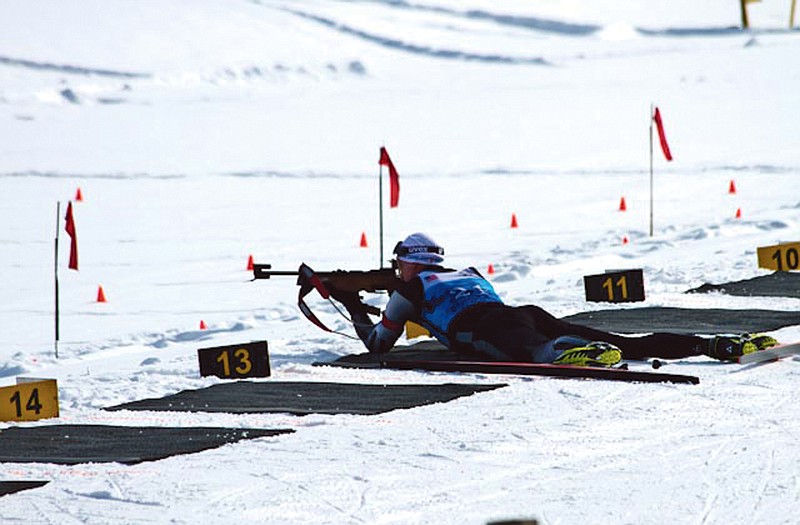When people think of sports in Missouri, skiing isn't at the top of the list. Much less skiing several miles followed immediately by shooting a rifle at a target the size of a silver dollar.
But don't tell that to several members of the Missouri National Guard.
Used as a training exercise, a physical challenge and a way to have fun, members of the Missouri National Guard biathlon team have taken a liking to the winter biathlon, a sport few Missourians are familiar with.
"I love it. There's no better joy in my life than pushing myself to the limit," Staff Sgt. Justin Neihart said.
The biathlon consists of a series of cross-country skiing events followed immediately by shooting. The skier carries the rifle on his or her back while maneuvering through a marked course to a shooting range. Once at the range, the skier then takes five shots - without using a scope - at a target the size of a silver dollar from a distance of 50 meters.
Then they do it all over again, this time taking shots at a slightly larger target.
Miss any of the targets? You get to do a penalty lap.
According to Chief Warrant Officer 2 Mitch Simpson, races usually consist of 1 kilometer, 7.5 km, 10 km, 12.5 km and 15 km, depending on the level of the competition.
"The most difficult aspect of it would be to be able to calm yourself down after sitting at anywhere from 2,000 to 8,000 feet of elevation from a hardcore race," Neihart said. "Imagine sprinting for 45 minutes and then trying to shoot a weapon. That's literally the comparison I steal sometimes after the track because it is a very grueling track. You are constantly taxed on wind and elevation and on top of that you are trying to breathe."
All of that is going on while 65-75 percent of the time a person is skiing uphill.
"I handpick these people based on their (physical training) scores and their shooting, how well they qualify," said Simpson, who is in charge of forming the team. "I'm not looking for someone for a weekend for shooting."
With the physically demanding nature of the sport and lack of snow in Missouri, it's impossible to simulate the conditions the group faces during competition.
So the crew heads to West Yellowstone, Mont., for nine days to train and prepare for the competition. They ski in the morning, break for lunch and then go out again until evening.
With limited funding, it's all the time the group gets to simulate what the conditions will be like in competition.
Simpson said he also runs 20-25 miles per week and bikes more than 100 miles in the same period to stay in shape and prepare.
"It's very intense training," Neihart said. "You have to be very dedicated. ... It's the only sport I've ever done where within five days of racing, every evening you go back out and you train again. Usually you just race and you're done for the day."
Neihart and Simpson, the team's captain, have both found something they love doing. But they got involved in a different manner.
Neihart, 27, received an email saying he met the requirements. The Jefferson City resident didn't have long to respond. It was a decision he doesn't regret today, as he joined the team in the winter of 2011.
"They said, "You meet the qualifications for the PT standards that are required. Would you like to participate in a winter biathlon?'" Neihart recalled. "I said, "Well, I don't really know what it is yet, let me look into it.' They gave me 24 hours to respond. That was as much as I was allowed and they had to turn it back in the next day. I just said yes."
While Neihart was sought out, Simpson, also a Jefferson City resident, saw a recruiting poster. The 51-year-old said it took him about a year to get to the right person.
It was a decision neither of them seem to regret.
This year's team took fifth place in the National Guard Bureau Championships held Feb. 22-March 1 in Minnesota. In the process, the squad beat several northern states.
Simpson was fourth at the regional competition in January where he was recognized as the top military shooter in the 10k sprint race when he hit nine out of 10 targets.
The team's success was a surprise to some, especially those with more snow. They were surprised the team from Missouri finished so high in the competition.
"They came over to the Missouri table and asked who the new guy was," Simpson said. "You see the old guy with the gray hair."
For the group, it's about more than just a competition. The biathlon prepares them for possible real-life situations they may face in combat. The origins of the biathlon go back to ski-incorporated warfare during the Scandinavian War in the early 1700s.
According to Simpson, the Army maintained a biathlon training center for military athletes in Fort Richardson, Ark., from 1958-1973. In 1973, the Army turned it over to the Vermont Army National Guard.
"It will take you into a situation where you have unknown variables, an unknown environment," Simpson said. "You have a task and a mission you have to perform very well."
Even with all the serious training the biathlon provides, the group still manages to take time to enjoy the race.
"That's what I really love, is I get to represent the state of Missouri and my family," Neihart said. "They just go crazy over the idea for me to be able to support my state in a sport that nobody has any idea about."

